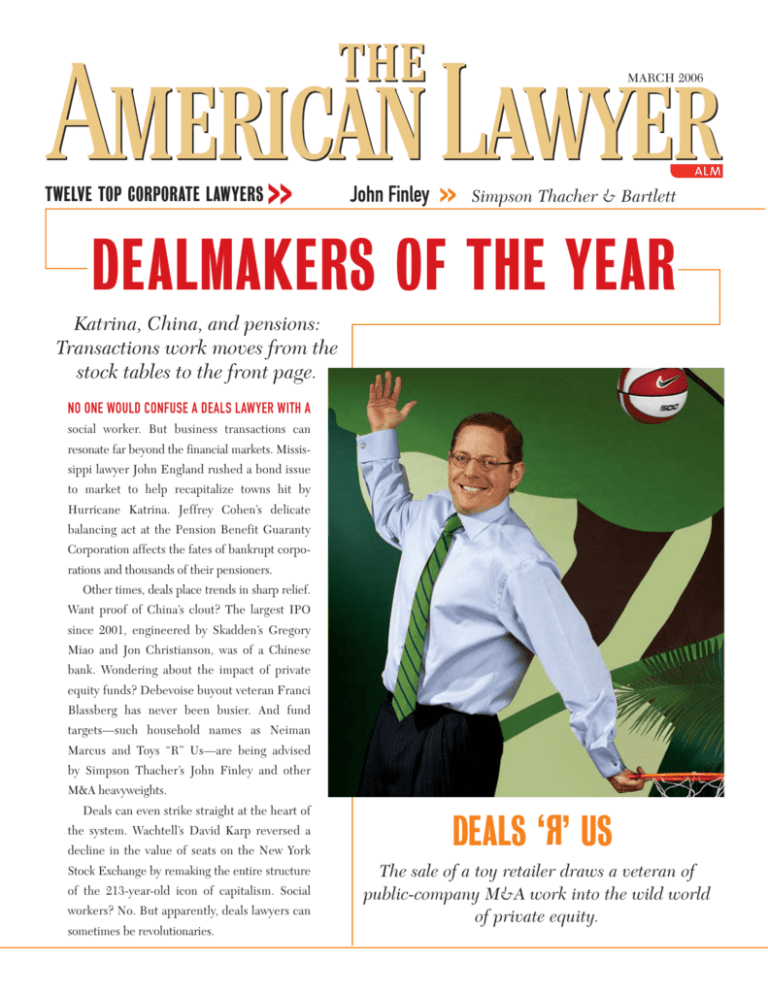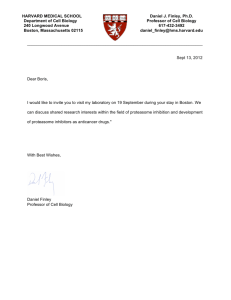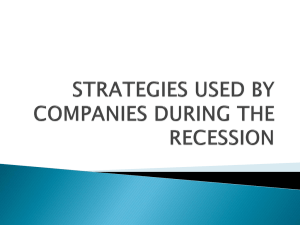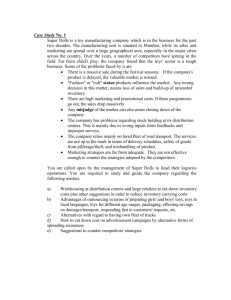
MARCH 2006
TWELVE TOP CORPORATE LAWYERS
>>
John Finley
>>
Simpson Thacher & Bartlett
DEALMAKERS OF THE YEAR
Katrina, China, and pensions:
Transactions work moves from the
stock tables to the front page.
NO ONE WOULD CONFUSE A DEALS LAWYER WITH A
social worker. But business transactions can
resonate far beyond the financial markets. Mississippi lawyer John England rushed a bond issue
to market to help recapitalize towns hit by
Hurricane Katrina. Jeffrey Cohen’s delicate
balancing act at the Pension Benefit Guaranty
Corporation affects the fates of bankrupt corporations and thousands of their pensioners.
Other times, deals place trends in sharp relief.
Want proof of China’s clout? The largest IPO
since 2001, engineered by Skadden’s Gregory
Miao and Jon Christianson, was of a Chinese
bank. Wondering about the impact of private
equity funds? Debevoise buyout veteran Franci
Blassberg has never been busier. And fund
targets—such household names as Neiman
Marcus and Toys “R” Us—are being advised
by Simpson Thacher’s John Finley and other
M&A heavyweights.
Deals can even strike straight at the heart of
the system. Wachtell’s David Karp reversed a
decline in the value of seats on the New York
Stock Exchange by remaking the entire structure
of the 213-year-old icon of capitalism. Social
workers? No. But apparently, deals lawyers can
sometimes be revolutionaries.
DEALS ‘R’ US
The sale of a toy retailer draws a veteran of
public-company M&A work into the wild world
of private equity.
>> MERGERS & ACQUISITIONS / PRIVATE EQUITY
DEALS ‘R’ US
>>
Simpson Thacher & Bartlett
The sale of a toy retailer draws a veteran of public-company
M&A work into the wild world of private equity.
>>
JOHN FINLEY HAS BUILT A CAREER advising big corporations on mergers and
acquisitions. In nearly 25 years at Simpson Thacher & Bartlett, he has
advised a stable of public companies, including such household names
as Seagram’s and Paramount. Last year he ran five major transactions,
four that closed, plus one that did not—nothing unusual there. What
was unusual were the folks sitting across the table from Finley. Two of
those transactions involved selling a company to private equity firms,
and another had a significant hedge fund component.
Such was the nature of M&A work in 2005. Private equity funds
became so active, and the amounts of money they were willing to pay
became so large, that even well-known public company lawyers like
Finley became protagonists in the private equity frenzy.
Finley began 2005 by putting the finishing touches on Kmart
Holding Corporation’s merger with Sears, Roebuck and Co.
Finley represented Kmart, which was backed by hedge fund
investor Edward Lampert.
That merger, announced
in late 2004, closed at a
Hours Finley
breakneck pace, with sharebilled in the
holder approval coming in
first four months March 2005. Finley then
turned back to the sale of
of last year.
Toys “R” Us, Inc., and after
that, segued into the sale of
The Neiman Marcus Group, Inc., to private equity funds.
Toys “R” Us was the kind of deal inside a deal, wrapped in another
deal, that can delight M&A lawyers—an 18-month saga of twists,
turns, and a court battle. Toys “R” Us went from seeking to spin off
one division or another, to, ultimately, selling the entire company to
private equity funds Kohlberg Kravis Roberts & Co., Bain Capital
LLC, and real estate firm Vornado Realty Trust. The $6.6 billion deal
was announced March 17, 2005. (KKR is a Simpson Thacher client,
although Finley says he has not worked on matters for it.)
Simpson Thacher began representing Toys “R” Us in 2000, when
Christopher Kay, then the company’s general counsel, hired the
firm as its primary outside counsel. Simpson Thacher represented the
company on such things as securities registration and litigation advice.
Then, in January 2004, Toys “R” Us embarked on a strategic review.
The company had been losing market share to Wal-Mart Stores, Inc.,
and other discount retailers, and its earnings were dismal. As it began
the review, Kay called on Finley, with whom he had worked before
while exploring a possible transaction.
By June 2004 the board decided to follow two tracks: selling its global
toys division—which included the entire international and domestic toys
business—and possibly spinning off its fast-growing Babies “R” Us
division. (The Toys “R” Us board was represented by David Fox of
Skadden, Arps, Slate, Meagher & Flom.) Investment bank Credit Suisse
First Boston LLC invited 29 potential buyers to inspect the global toys
division for a purchase. While overseeing the due diligence for the sale,
Finley was also drafting initial documents for a Babies “R” Us spin-off.
Finley never got as far as a Securities and Exchange Commision
registration: The spin-off strategy was tabled in November 2004. Instead,
as 2004 ended, Finley oversaw the drafting of more than a dozen
agreements in preparation for the sale of the global toys division. They
included a separation agreement, a purchase agreement, IP agreements,
licensing agreements, and service agreements. Throughout the deal,
Finley had a supporting cast of about 30 Simpson Thacher lawyers.
By early January 2005 the bidders for the global toys division were
narrowed to four groups, and the final bidding process began. The
auction process had a twist, of Finley’s design: Each bidding group was
required to submit a markup of a merger agreement but with no price
bid attached. The reason was the deal’s complexity. The division
maintained an intricate set of licensing arrangements and inventory and
warehouse deals with its own sibling companies and outside vendors, so,
9 27
John Finley
Finley says, it was best to clarify the terms of the deal before price
entered the picture. “[Finley] and his team brought tremendous clarity
so the board could truly analyze what the differences were between
these contracts, putting aside price,” says Blackstone Group senior
managing director Arthur Newman, a former member of Toys “R” Us’s
board and executive committee. After receiving the initial terms, Finley
sent the bidders a new agreement containing the best terms from each
bidder, as assessed by Toys “R” Us. (Finley had used a similar process in
the sale of client Grey Global Group Inc. to WPP Group plc in 2004.)
The auction process was well on its way when hedge fund Cerberus
Capital Management, L.P., knocked the nearly completed bidding
process off kilter by submitting a bid for all of Toys “R” Us. Kay says that
Finley had already prepared a to-do list should such a bid materialize
(more than six months earlier, a handful of potential buyers had casually
discussed the possibility with Credit Suisse). “A wonderful hallmark of
John is that we were not unprepared for this alternative,” says Kay, who
left Toys “R” Us as chief operations officer after the company’s sale.
Toys “R” Us shunned the first Cerberus offer. Finley advised the
company on how to craft its message to Cerberus—and then, after
Cerberus upped its offer a month later, to inform other bidders that
it would open up an auction for the whole company. Newman says
that Finley helped the company devise strategy, not just draw up
documents: “This is what Joe Flom and Marty Lipton became famous
for—the strategic advice, not just the legal advice.” Final bids were
submitted on March 16, and the Toys “R” Us board worked into the
early morning hours of March 17 to pick a winner. Finley negotiated
the merger agreement with KKR in those final hours.
No sooner was the auction over than a group of shareholders,
represented by lawyers from Lerach Coughlin Stoia Geller Rudman
& Robbins, sued Toys “R” Us and its board in Delaware Chancery
Court to stop the sale. They argued that the board did not get the best
possible deal for the company and that it should have conducted a
longer bidding process. In June, Vice Chancellor Leo Strine, Jr., ruled
against the plaintiffs. In his 80-page opinion, Strine praised the board
for “maximizing value” for shareholders throughout the sale. Says
Finley: “The process was validated.”
Finley barely had time to look back. By then, he was steeped in
closing the sale of Neiman Marcus to Texas Pacific Group and Warburg
Pincus LLC. Finley had represented the family partnerships that
controlled Neiman since the late eighties, advising them on corporate
governance and M&A matters. Like the Toys “R” Us sale, Neiman’s auction
was a scramble, with various private equity bidders coalescing into
groups toward the end of the sale, and each consortium bidding in secrecy.
“John did a great job handling the contract management process with
each bidding party,” says former Neiman vice-chairman Robert Smith.
Finley says he is growing accustomed to working across the table
from private equity funds. One difference between the funds and public
companies, he says, is dealing with a consortium of buyers, rather than a
single strategic buyer. And he’s observing that difference again this year:
He represents VNU Business Media, Inc., in a possible sale to a private
equity consortium.
—CARLYN KOLKER
This article is reprinted with permission from the March 2006 edition of THE
AMERICAN LAWYER. © 2006 ALM Properties, Inc. All rights reserved. Further duplication without permission is prohibited. For information, contact ALM Reprint
Department at 800-888-8300 x6111 or www.almreprints.com. #001-03-06-0016










